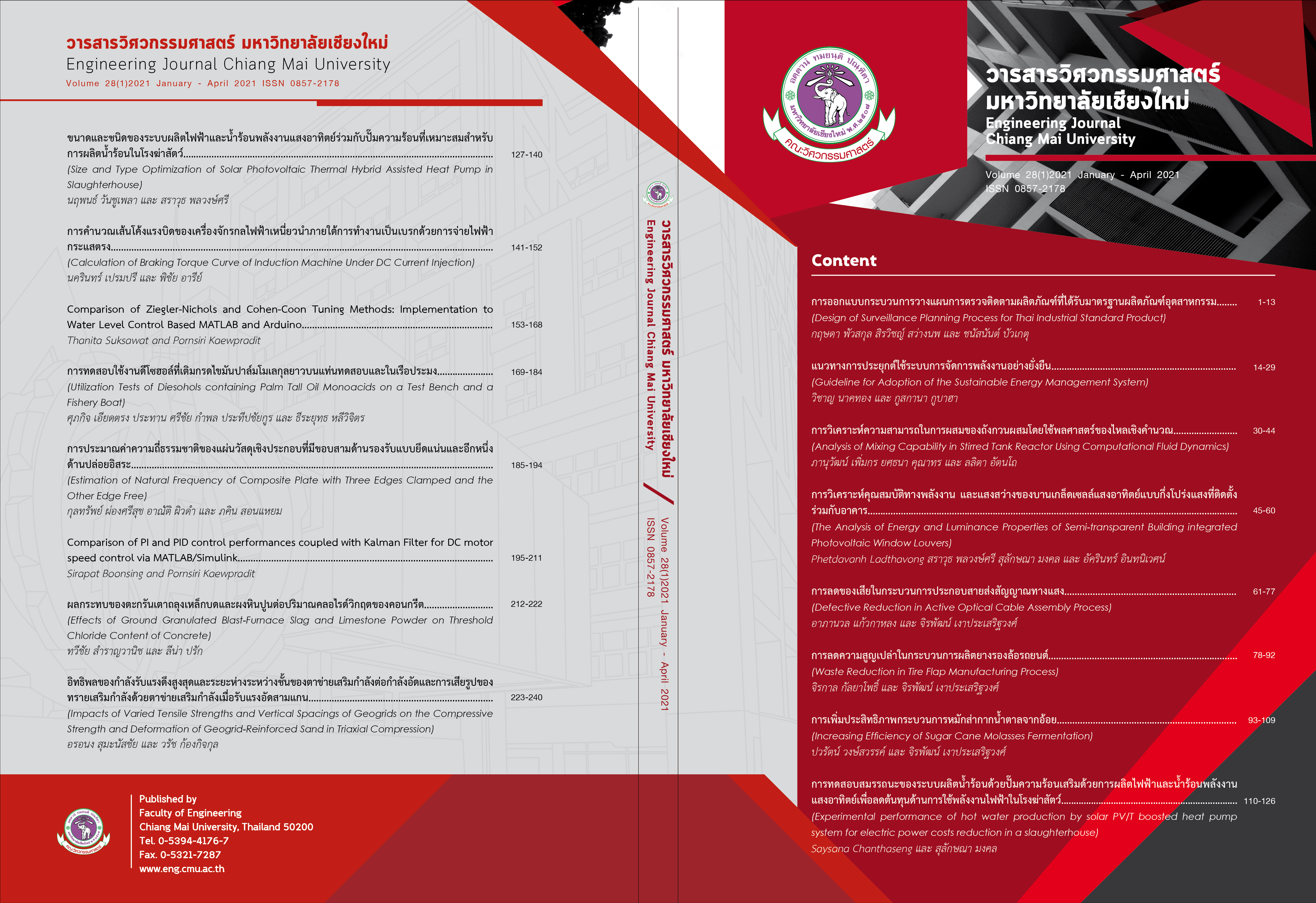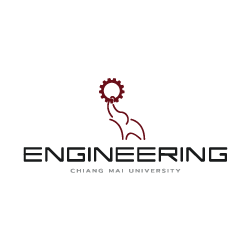Analysis of Mixing Capability in Stirred Tank Reactor Using Computational Fluid Dynamics
Keywords:
Stirred tank reactor, CFD, Turbulence model, MixingAbstract
The Stirred Tank Reactor (STR) is widely used in the industry. Understanding the flow characteristics within the tank is important in determining the performance of the mixing process. The objective of this paper presents the study of the flow characteristics and velocity distribution of fluid within the Stirred Tank Reactor (STR) using 8 blades Rushton turbines in the middle of the tank to drive. Calculate the flow results using Computational Fluid Dynamics (CFD). The Large Eddy Simulation (LES) using to capture the turbulence and the Sliding Mesh technique (SM) to simulate the impeller motion. The study of mixing characteristics at impeller speeds of 100, 200, and 300 rpm. The study results showed that the tangent velocity generated vortex flow around the shaft within the stirring tank. When continuous mixing, the flow characteristics will be steady-state. This flow characteristic affects the mixing capability of the process that requires turbulence for the mass transfer between the fluids. However maintaining turbulence in the mixing process required high energy.
References
Sbrizzai, F., Lavezzo, V., Verzicco, R., Campolo, M. and Soldati, A. Direct Numerical Simulation of Turbulent Particle Dispersion in an Unbaffled Stirred-Tank Reactor. Chemical Engineering Science, 2006; 61(9):2843-2851.
Gimbun,J.,Rielly, C.D., Nagy, Z.K. and Derksen, J. J. Detached Eddy Simulation on the Turbulent Flow in A Stirred Tank. AIChE Journal, 2012; 58(10):3224–3241.
Derksen, J. Long-Time Solids Suspension Simulations by means of a Large-Eddy Approach. Chemical Engineering Research and Design, 2006; 84(1):38–46.
Li, Z.,Hu, M.,Bao, Y. and Gao, Z. Particle Image Velocimetry Experiments and Large Eddy Simulations of Merging Flow Characteristics in Dual Rushton Turbine Stirred Tanks. Industrial and Engineering Chemistry Research, 2012; 51(5): 2438–2450.
Gillissen,J. J. and Van den Akker,H. E. Direct Numerical Simulation of the Turbulent Flow in a Baffled Tank Driven by a Rushton Turbine. AIChE Journal, 2012; 58(12):3878–3890.
Talaga,J. and Fort, I. The Velocity Field in the Discharge Stream from a Rushton Turbine Impeller. The 14th European Conference on Mixing. September 10, Warszava, Poland, 2012.
Venneker, B.C.,Derksen, J.J. and Van den Akker, H.E.A. Turbulent Flow of Shear-Thinning Liquids in Stirred Tanks-the Effects of Reynolds Number and Flow Index. Chemical Engineering Research and Design, 2010; 88(7):827–843.
Versteeg,H.K. and Malalasekera,W. An Introduction to Computational Fluid Dynamics.2ndEdition, John Wiley & Sons, New York, 2007.
Kundu,P. Cohen, I. and Dowling, D. Fluid Mechanics.5th Edition, Elsevier, UK, 2012.
Rojanaratanangkule, W. Advanced Theories in Fluid Mechanics. Department of Mechanical Engineering, Chiang Mai University, 2016.
Paul, E.L., Atiemo‐Obeng, V.A. and Kresta, S.M. Handbook of Industrial Mixing: Science and Practice. John Wiley & Sons, 2004.
Verzicco, R., Iaccarino, G., Fatica, M. and Orland, P. Flow in an Impeller Stirred Tank Using an Immersed‐Boundary Method. AIChE journal,2004; 50(6): 1109-1118.
Christopher J. Open Foam User Guide, V5.0. Open FOAM Foundation Ltd., 2017.
Murthy, J. Y., Mathur, S. R., and Choudhary, D. CFD Simulation of Flows in Stirred Tank Rectors Using a Sliding Mesh Technique. 8th Europe Conference on Mixing, September 21-23, Cambridge, UK, 1994; 155-162.
Joshi, J.B., Nere, N.K., Rane, C.V., Murthy, B.N., Mathpati, C.S., Patwardhan, A.W. and Ranade, V.V. CFD Simulation of Stirred Tanks: Comparison of Turbulence Models. Part I: Radial Flow Impellers. Canadian Journal of Chemical Engineering, 2011; 89(1):23-82.
Joshi, J.B., Nere, N.K., Rane, C.V., Murthy, B.N., Mathpati, C,S., Patwardhan, A.W. and Ranade, V.V. CFD Simulation of Stirred Tanks: Comparison of Turbulence Models(Part II: Axial Flow Impellers, Multiple Impellers and Multiphase Dispersions). Canadian Journal of Chemical Engineering, 2011; 89(4):754-816.
ANSYS FLUENT theory guide: Release 16.2. ANSYS, Canonsburg, Pennsylvania (2013).
Huang, W., and Li, K. CFD Simulation of Flows in Stirred Tank Reactors Through Prediction of Momentum Source. Nuclear Reactor Thermal Hydraulics and Other Applications, 2013: 135-153.
Kysela, B., Konfrst, J., Fort, I. and Chara, Z. CFD Simulation of the Discharge Flow from Standard Rushton Impeller. International Journal of Chemical Engineering, 2014; 706149: 1-7.
Chara, Z., Kysela, B., Konfrst, J. and Fort, I. Study of Fluid Flow in Baffled Vessels Stirred by a Rushton Standard Impeller. Applied Mathematics and Computation,2016; 272(3): 614-628.
Downloads
Published
Issue
Section
License
ลิขสิทธิ์ของบทความที่ตีพิมพ์ในวารสารฉบับนี้จะยังเป็นของผู้แต่งและยินยอมให้สิทธิ์เผยแพร่กับทางวารสาร
การเผยแพร่ในระบบวารสารแบบเปิดนี้ บทความจะสามารถนำไปใช้ได้ฟรีในการศึกษา และในทางที่ไม่เกี่ยวกับการค้า




